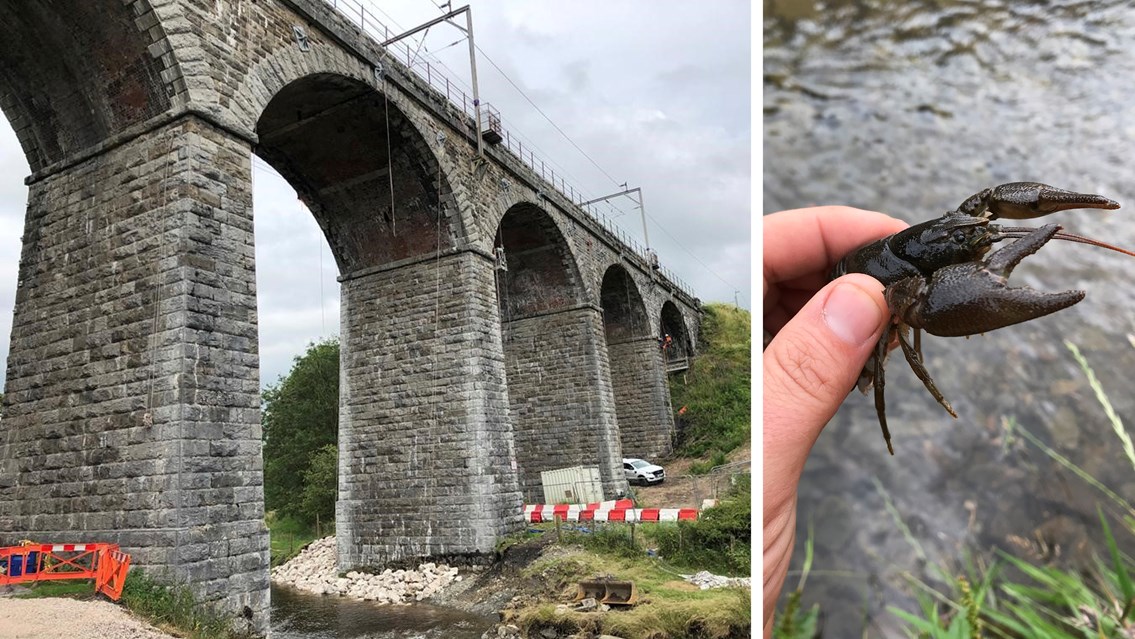Tuesday 20 Aug 2019
Endangered crayfish rescued during Victorian viaduct strengthening
- Region & Route:
- North West & Central
Work to reinforce a 173-year-old railway viaduct is providing a more reliable railway for passengers and helping protect endangered crayfish in Cumbria.
Water erosion means the Grade II listed Docker Garths viaduct in Lambrigg needs to be repaired and strengthened.
The £750,000 investment as part of the Great North Rail Project required the Flodder Beck river to be diverted* and wildlife safely moved so the viaduct’s foundations could be reinforced.
Two hundred endangered white clawed crayfish, along with another 400 less rare fish, were caught and moved downstream**.
Andrew Campuzano, ecologist at Network Rail, said: “We are refurbishing Docker Garths viaduct as part of a £750,000 Great North Rail Project investment. This will help ensure it continues to be safe and reliable for economically important Anglo-Scottish passenger and freight trains for years to come.
“We take our environmental responsibilities very seriously and ensured we removed the endangered white clawed crayfish and other fish before work started.”
White clawed crayfish have nearly been wiped out after American signal crayfish were introduced into the UK in the 1970s as food for trout farms but escaped into the wild.
The larger invasive species not only competes for the same food, but also carries a disease which is deadly for the native crayfish.
The Docker Garths viaduct carries Europe’s busiest mixed-use railway - the West Coast main line - over the Flodder Beck valley between England and Scotland.
The essential safety work on this Victorian viaduct is being carried out until the end of August.
Once complete it will provide reliable passenger and freight journeys on the economically important route through Cumbria for decades to come.
Notes to Editors
*The Flodder Beck river has been diverted so engineers can reinforce the viaduct’s vulnerable foundations with what’s known as ‘rock armour’. This is when large boulders are positioned around the viaduct’s supports which can then take the full force of the river flow and stop erosion of the structure itself.
** Due to the high number of native species recorded during the fish rescue, the figures have been reported to Natural England and the Environment Agency. These findings could help support the river’s designation as a site of special scientific interest (SSSI) in the future.
Contact information
Passengers / community members
Network Rail national helpline
03457 11 41 41
Latest travel advice
Please visit National Rail Enquiries
Journalists
Network Rail press office - North West & Central Region
0330 854 0100
NWCmediarelations@networkrail.co.uk
About Network Rail
We own, operate and develop Britain's railway infrastructure; that's 20,000 miles of track, 30,000 bridges, tunnels and viaducts and the thousands of signals, level crossings and stations. We run 20 of the UK's largest stations while all the others, over 2,500, are run by the country's train operating companies.
Usually, there are almost five million journeys made in the UK and over 600 freight trains run on the network. People depend on Britain's railway for their daily commute, to visit friends and loved ones and to get them home safe every day. Our role is to deliver a safe and reliable railway, so we carefully manage and deliver thousands of projects every year that form part of the multi-billion pound Railway Upgrade Plan, to grow and expand the nation's railway network to respond to the tremendous growth and demand the railway has experienced - a doubling of passenger journeys over the past 20 years.
Follow us on Twitter: @networkrail
Visit our online newsroom: www.networkrailmediacentre.co.uk

